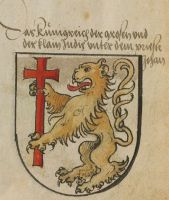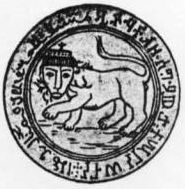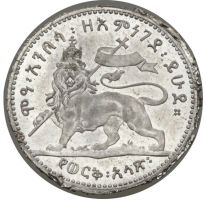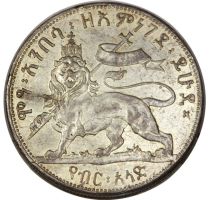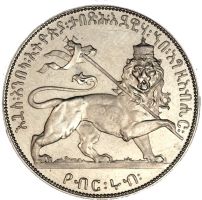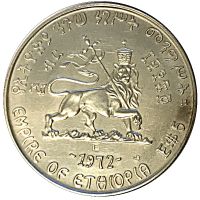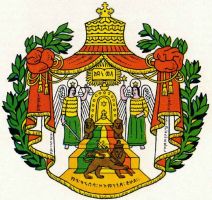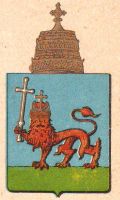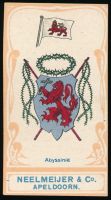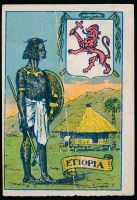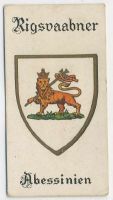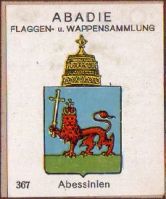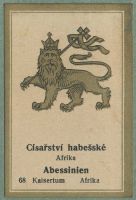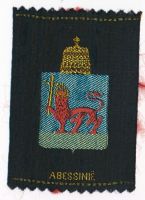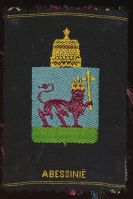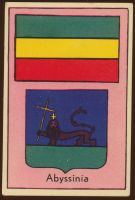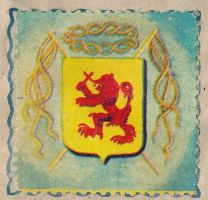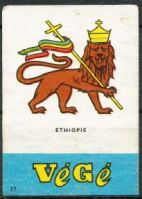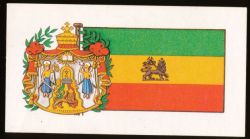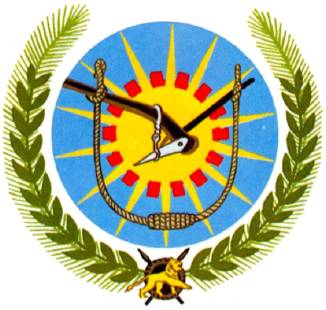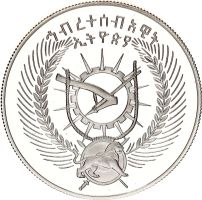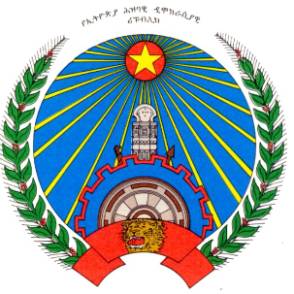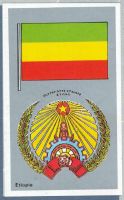National Arms of Ethiopia
NATIONAL COAT OF ARMS OF ETHIOPIA
Official blazon
Azure, a pentagram with five rays of light or.
Origin/meaning
The current national emblem was adopted in 1996.
The pentagram has had different official meanings. At present the pentagram stands for the unity of the people and nationality of the Federal Democratic Republic of Ethiopia. In a wider sense represents the shared desire of the state, the people and the religion of Ethiopia to make a united nation.
I have no idea why the pentagram was chosen as a symbol.
Historical arms
1885-1974
The historical symbol for the rulers and the state of Ethiopia was a lion passant since the rule of Emperor Theodore II (1855-1868). The lion was seen as the lion of Judah and represented the Christian belief of the Emperors. The Emperor traces his ancestry to the Queen of Sheba and King Solomon and bears as his official title 'Conquering Lion of the Tribe of Judah, Elect of God, Emperor of Ethiopia'.
During the reigns of different Emperors, the lion has been facing either left or right and by Menelik II (1889-1913) the lion was given a processional cross in his paw, in a later version augmented with a streamer. The lion remained the official symbol for the state until the end of the rule of Emperor Haile Selassie in 1974.
Besides the lion as state arms, the Emperors also used large Imperial arms. It displays symbols of the Emperor's power, dignity and supremacy; upon the Throne of Solomon lies the orb. Before the throne, which is flanked by angels, one of which holds a sword and scales and the other a golden star, stands the Lion of Judah with a cross and streamers. Above the throne is the Bible in glory and at the foot is the Amharic legend 'The Conquering Lion of the Tribe of Judah'. These large arms have been in use from the 1890s until 1974.
In many European publications the arms were shown as a red lion in silver, holding a cross, see images below. This image has never been used in Ethiopia itself. This composition dates already from medieval times referring to the Kingdom or Prester John, a legendary Christian King living in the Orient. In the 15th century Portuguese explorers came to believe that the term was a reference to Ethiopia, by which time it had been an isolated Christian "exclave" distant from any other Christian-ruled territory. Imaginary arms for this Kingdom were a red or golden lion holding a cross on a silver shield, see below for an image from an armorial from 1530.
Image gallery
The arms on a Dutch card, 1900s
The arms in a Spanish album, 1920s
The arms on a Danish card, 1925
The arms in an Austrian album, 1930
The arms in a Czech album, 1931
The arms in a German album, 1932
The arms in a Dutch album, 1933
The arms in a Dutch album, 1933
The arms in a Dutch album, 1947
The arms in a Spanish album, 1949
The arms on a Dutch matchbox label, 1960s
The arms in an English album, 1967
1936-1941
In this time the country was occupied by Italy. See Italian East Africa.
1975-1987
During this time Ethiopia was a Socialist Republic and a new State Emblem was designed in 1975.
| Amharic | blazon wanted |
| English | Azure, a cogwheel Gules charged with a fourteen rayed sun Or, charged with a plow tied with a cord in the form of the first letter of the Amharic alphabet Hoi. The shield surrounded by two branches of the silver cluster leaf (Terminalia sericea - Combretaceae) and two leaves of the oil palm, on the junction a native shield on two spears in saltire and over all a lion passant to the sinister. |
In this emblem the sun has fourteen rays which symbolizeă the fourteen districts of the nation, the plow symbolizes agriculture and the cogwheel industry. The letter Hoi symbolizes the necessity of alphabetisation.
The silver cluster leaf is used for construction and charcoal production and is typical for the wooded savanna. The palm leaves symbolize the importance of palm oil production.
The shield, spears and lion are the symbol of the Ethiopian Defense Force.
Image gallery
1987-1991
During this time Ethiopia was renames as the People's Democratic Republic of Ethiopia and a new State Emblem was designed in 1987.
| Amharic | blazon wanted |
| English | Azure, in chief a golden rayed disc Gules charged with a five pointed star Or, in base a cogwheel issuant Azure, rimmed Gules charged with an Ethiopian shield proper, posed on a rifle and a spear in saltire also proper, and issuant therefrom the upper part of the Aksum obelisk.The shield surrounded by two branches of the silver cluster leaf (Terminalia sericea - Combretaceae) and two leaves of the oil palm, on the junction a red ribbon charged with a lion’s head. In chief the name of the republic in Amharic. |
In the new emblem the star symbolises the struggle of the people for the construction of a new state. The Aksum Obelisk refers to the historical Empire of Aksum, the cradle of Ethiopia in the first century AD and Aksum is also a Holy City. The cogwheel represents industry and the lion's head represents strength and was the symbol of the head of the State. The rays refer to proper administratio.
The colours were defined as red for heroism and scrifice and gold for hope and justice.
Image gallery
The arms in a Spanish album, 1994
1991-1995
During this time a transitional government operated.
I have no information on the meaning of this emblem.
Literature : Briggs, 1974; https://www.rode-leeuw.nl/
This page is part of the Ethiopia heraldry portal |
Heraldry of the World |
|
Civic heraldry:
|
Other heraldry: |
Contact and Support
Partners:
Your logo here ?
Contact us
© since 1995, Heraldry of the World, Ralf Hartemink 
Index of the site

